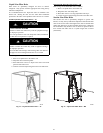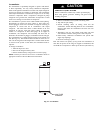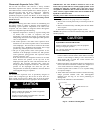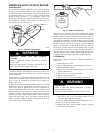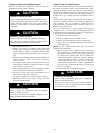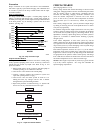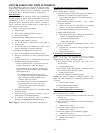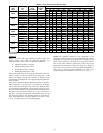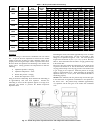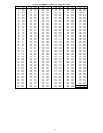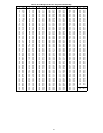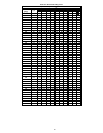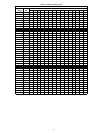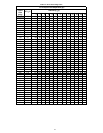
35
High Superheat with Normal or High Suction
Pressure
NOTE: Normal to High suction pressure is considered
for R--22: > ∼65 psig, Puron: > ∼110 psig. An application issue or
other system component failure typically causes this condition.
15. Check airflow, sensing bulb tightness, orientation on vapor
tube and ensure bulb is properly wrapped.
S If OK proceed to Step 16
16. R--410A Systems: Make sure proper valve is used (Not
R--22)
S If OK proceed to Step 17
17. Check for even temperature distribution at outlet of each
circuit of evaporator
S If OK proceed to Step 18
18. Check for high evaporator load: Return Air Leaks, high
indoor wet bulb and/or dry bulb temp, undersized system,
etc.
S If OK proceed to Step 19
19. Check that compressor is pumping properly
S Loose Rule of Thumb: Is discharge saturated ∼20°F
higher than ambient temperature? Is discharge superheat
between 15_F and 50_F?
Hunting
Superheat
NOTE: Hunting is when the valve superheat swings more than
10°F Superheat in repetition. This is typically an application issue.
20. Check for obvious kinked or pinched distributor (capillary)
tubes causing imbalance to the circuiting.
S If OK proceed to Step 21
21. Check that proper size valve is used per Product Literature.
S If OK proceed to Step 22
22. Check airflow, sensing bulb tightness, orientation on vapor
tube and ensure bulb is properly wrapped.
S If OK proceed to Step 23
23. Check for even temperature distribution (±5° difference) at
outlet of each circuit of evaporator and for even air
distribution over all evaporator slabs
S If OK proceed to Step 24.
24. Move sensing bulb further down suction line.
S If problem not corrected, replace valve
Pseudo Evaporator Superheat
Instructions
The Pseudo Evaporator Superheat calculates the superheat at the
outlet of the evaporator with known and available information.
Because there generally is not a pressure port on the vapor line at
the indoor coil, this procedure allows the service personnel to
evaluate the evaporator superheat with the vapor pressure port at
the outdoor unit.
The method requires the following information:
S Suction line temperature at the outlet of the evaporator
(°F).
S Suction line pressure at the outdoor unit (psig).
S Outdoor nominal unit size (btuh).
S Suction line equivalent line length (ft).
S Suction line pressure drop from tables (Table 6 and Table
7).
S Pressure--Temperature relationship for refrigerant used
(P--T Chart).
If system uses a vapor line the same size as vapor service valve
fitting or larger AND the line set equivalent length is 80 feet or
less, the pressure drop in vapor line of line set can be ignored.
1. Take suction line temperature at outlet of evaporator at
indoor unit.
2. Take suction service valve pressure at OD unit.
3. Determine lineset vapor line equivalent length and tube
diameter.
4. Determine suction line pressure drop from Table 6 (Puron)
or Table 7 (R--22).
5. Calculate Pseudo Evaporator Superheat.
S Add the suction line pressure drop to the pressure
reading obtained at suction service valve.
NOTE: For nominal and larger diameter vapor lines with standard
length linesets (vapor line same size as service valve fitting size and
larger with equivalent length less than 80 ft) the pressure drop can
be ignored – usevapor service valve pressure and evaporator outlet
temperature to calculate superheat
S Determine saturated evaporator temperature from a
refrigerant pressure temperature relationship chart (PT
chart).
S Subtract saturated evaporator from evaporator suction
line temperature to obtain evaporator superheat.
90°STD
90° LONG RAD 45° STD
A01058
Fig. 32 – Tube Fitting Geometry
Table 5—Fitting Losses in Equivalent Feet
TUBE SIZE OD
(IN.)
90° STD (A) 90° LONG RAD (B) 45° STD (C)
1/2 1.2 0.8 0.6
5/8 1.6 1.0 0.8
3/4 1.8 1.2 0.9
7/8 2.0 1.4 1.0
1 ---1 /8 2.6 1.7 1.3



